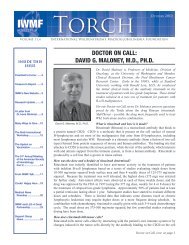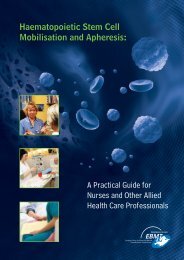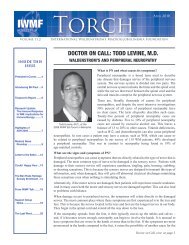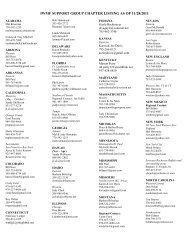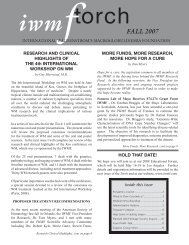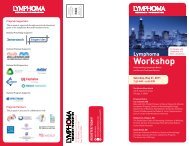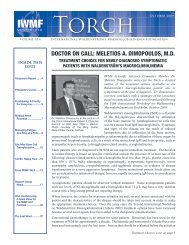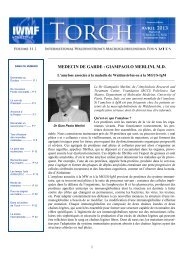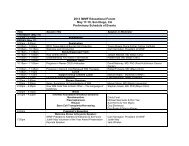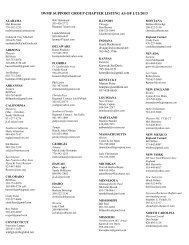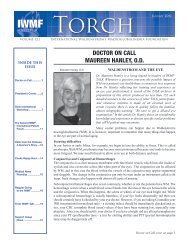Spring 2008 - International Waldenstrom's Macroglobulinemia ...
Spring 2008 - International Waldenstrom's Macroglobulinemia ...
Spring 2008 - International Waldenstrom's Macroglobulinemia ...
Create successful ePaper yourself
Turn your PDF publications into a flip-book with our unique Google optimized e-Paper software.
PAGE 10<br />
The 4 th <strong>International</strong>, cont. from page 9<br />
Boston, MA. Resveratrol is synthesized by a wide variety<br />
of plant species including grapes. In vitro data demonstrates<br />
that resveratrol has significant antitumor activity in WM.<br />
Resveratrol induces significant cytotoxicity and inhibition of<br />
DNA synthesis. In contrast, resveratrol did not significantly<br />
affect proliferation of peripheral blood mononuclear cells<br />
from healthy donors. Clinical trials are pending.<br />
Simvastatin, an HMG-CoA inhibitor, induces in vitro<br />
antitumor activity in Waldenstrom’s macroglobulinemia.<br />
A.S. Moreau, Bing Center for Waldenstrom<br />
<strong>Macroglobulinemia</strong>, Dana-Farber Cancer Institute. Low total<br />
cholesterol levels have been observed among WM patients;<br />
there also appears to be an inverse relationship between the<br />
IgM serum level and LDL cholesterol serum level. This study<br />
shows that simvastatin (Zocor) has significant antitumor<br />
activity in WM in vitro. Simvastatin induced-cytotoxicity<br />
was also noted to be enhanced by bortezomib (Velcade) or<br />
fludarabine. Clinical trials are pending.<br />
Protein kinase inhibitor, enzastaurin, induces in<br />
vitro and in vivo antitumor activity in Waldenstrom’s<br />
macroglobulinemia. A.S. Moreau, Medical Oncology, Dana-<br />
Farber Cancer Institute, Boston, MA. The PKCb pathway<br />
regulates cell survival and growth, as well as migration and<br />
homing in many B-cell malignancies. The PKCb inhibitor<br />
enzastaurin has significant antitumor activity in WM in vitro<br />
and in vivo. Clinical trials are pending.<br />
Perifosine, an oral bioactive novel Akt inhibitor, induces<br />
in vitro and in vivo antitumor activity in Waldenstrom’s<br />
macroglobulinemia. X. Leleu, Department of Medical<br />
Oncology, Dana-Farber Cancer Institute, Boston, MA. The<br />
PI3k/Akt pathway is a critical regulator of cell survival. Upregulation<br />
of members of the PI3k/Akt pathway is noted in<br />
WM. Perifosine has significant antitumor activity in WM<br />
both in vitro and in vivo. Clinical trials are underway.<br />
The combination of perifosine with bortezomib and<br />
rituximab provides synergistic anti-tumor activity in<br />
Waldenstrom’s macroglobulinemia. X. Leleu, Medical<br />
Oncology, Dana-Farber Cancer Institute and Harvard Medical<br />
School, Boston, MA. The combination of bortezomib<br />
(Velcade) + perifosine + Rituxan provides strong synergistic<br />
activity by targeting different signaling pathways activated<br />
in WM. Bortezomib (Velcade) + perifosine did not induce<br />
cytotoxicity in healthy-donor peripheral blood mononuclear<br />
cells or in hematopoietic stem cells.<br />
Phase II trial of perifosine (KRX-0401) in relapsed<br />
and/or refractory Waldenstrom’s macroglobulinemia:<br />
preliminary results. I.M. Ghobrial, Dana Farber Cancer<br />
Institute, Boston, MA. The Akt pathway is up-regulated<br />
in patients with WM. The Akt inhibitor perifosine causes<br />
growth inhibition in models of WM. This phase II clinical<br />
trial aims to determine safety and activity of perifosine in<br />
patients with relapsed/refractory WM. Perifosine appears to<br />
be well tolerated and shows activity in patients with relapsed<br />
WM. Updated data will be presented at the <strong>2008</strong> IWMF<br />
Educational Forum in Los Angeles CA.<br />
Cladribine (2-CDA) and rituximab combination treatment<br />
for patients with Waldenstrom’s macroglobulinemia<br />
(WM) or small lymphocytic lymphoma (SLL): clinical<br />
preliminary reports of a multicenter study. D. Laszlo,<br />
European Institute of Oncology, Milan. Combinations<br />
of nucleoside analogues and rituximab are effective for<br />
treatment of WM. This study tested the efficacy of 2-CDA<br />
in combination with rituximab in the treatment of newly<br />
diagnosed/pretreated WM (or SLL) patients requiring<br />
treatment. The combination therapy consisted of rituximab<br />
on day 1 followed by 2-CDA (sc injection) for 5 consecutive<br />
days. Each cycle was administered monthly for 4 times. 21<br />
WM patients were followed for a median of 12 months;<br />
11 patients achieved CR/PR (30% of them presenting a<br />
molecular clearance in blood marrow); MR in 6 cases; SD in<br />
1 case and PD/NR in 3 cases.<br />
Fludarabine, Cyclophosphamide and Rituximab (FCR)<br />
an effective regimen characterized by high incidence of<br />
delayed responses in Waldenstrom’s macroglobulinemia.<br />
A. Tedeschi, Departments of Hematology, Niguarda Ca’<br />
Granda Hospital Milan, Italy. The FCR regimen is active<br />
and well tolerated in symptomatic WM patients, and even in<br />
previously heavily pre-treated patients. The high incidence<br />
and long lasting episodes of neutropenia did not cause major<br />
infection problems. Progressive delayed responses have also<br />
been observed in patients with longer follow-up.<br />
2-CDA-cyclophosphamide +/- rituximab for symptomatic<br />
WM. S.K. Thomas, University of Texas M.D. Anderson<br />
Cancer Center, Houston, TX. A retrospective analysis of<br />
this institution’s experience with 47 previously untreated<br />
patients with symptomatic WM, treated with 2 consecutive<br />
6-week courses of 2-CdA sc tid x 7d + cyclophosphamide<br />
(Cy) po bid x 7d (29 patients) alone or with rituximab q<br />
wk x 4 wk (18 patients). With 2-CdA-Cy, overall response<br />
rate (ORR) was 83%, including complete response (CR) in<br />
4% (1 patient). With 2-CdA-Cy-Rit, ORR was comparable<br />
at 94%, including CR in 17% (3 patients). Median times to<br />
remission were similar at 2.3 (2-CdA-Cy) and 2.4 months<br />
(2-CdA-Cy-Rit); a trend towards longer duration of first<br />
remission (DOR) for patients treated with 2-CdA-Cy-Rit<br />
(58.6mos vs. 25.6mos) was noted. After only 2 courses of<br />
treatment with 2-CdA-Cy combinations, high response rates<br />
with little toxicity, long remission durations, longer time to<br />
need for re-treatment, and prolonged survival were obtained.<br />
When re-treated, second remissions were long as well. The<br />
use of limited 2-CdA-Cy based regimens as the treatment of<br />
choice for previously untreated patients with symptomatic<br />
WM is therefore supported at this institution.<br />
The 4 th <strong>International</strong>, cont. on page 11



